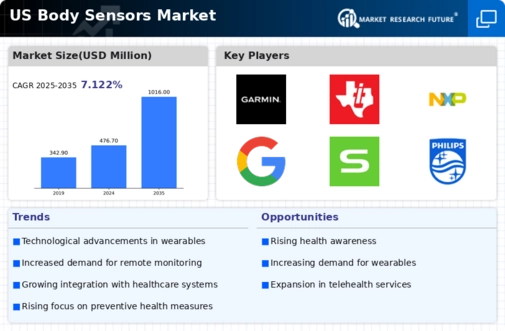The body sensors market is currently characterized by a dynamic competitive landscape, driven by technological advancements and increasing consumer demand for health monitoring solutions. Key players such as Medtronic (US), Philips (NL), and Abbott (US) are strategically positioned to leverage innovation and partnerships to enhance their market presence. Medtronic (US) focuses on integrating advanced sensor technologies into its medical devices, while Philips (NL) emphasizes digital health solutions that facilitate remote patient monitoring. Abbott (US) is also investing heavily in continuous glucose monitoring systems, which are gaining traction among diabetic patients, thereby shaping a competitive environment that prioritizes innovation and patient-centric solutions.
In terms of business tactics, companies are increasingly localizing manufacturing to reduce supply chain vulnerabilities and optimize operational efficiency. The market structure appears moderately fragmented, with several players vying for market share. This fragmentation allows for diverse offerings, yet the collective influence of major companies like Siemens Healthineers (DE) and GE Healthcare (US) is significant, as they continue to set industry standards through their advanced technologies and comprehensive product portfolios.
In October 2025, Siemens Healthineers (DE) announced a strategic partnership with a leading tech firm to develop AI-driven body sensors aimed at enhancing diagnostic accuracy. This collaboration is expected to integrate machine learning algorithms into sensor technology, potentially revolutionizing how healthcare providers monitor patient health. The strategic importance of this move lies in its potential to improve patient outcomes and streamline healthcare processes, thereby reinforcing Siemens Healthineers' position as a leader in the market.
In September 2025, GE Healthcare (US) launched a new line of wearable sensors designed for real-time health monitoring, targeting both clinical and consumer markets. This product line aims to provide comprehensive health insights, which could significantly enhance patient engagement and adherence to treatment plans. The introduction of these wearables reflects GE Healthcare's commitment to innovation and its strategy to capture a larger share of the growing consumer health segment.
In November 2025, Abbott (US) expanded its distribution network for its continuous glucose monitoring systems, aiming to reach underserved markets in the US. This strategic move is likely to enhance accessibility to critical health monitoring tools, thereby positioning Abbott favorably in a competitive landscape that increasingly values inclusivity and patient access to technology. The expansion underscores Abbott's focus on addressing the needs of diverse patient populations, which is essential for sustaining growth in the body sensors market.
As of November 2025, current competitive trends indicate a strong emphasis on digitalization, sustainability, and the integration of AI technologies within the body sensors market. Strategic alliances are becoming increasingly pivotal, as companies seek to combine their strengths to innovate and enhance product offerings. Looking ahead, competitive differentiation is expected to evolve, shifting from traditional price-based competition to a focus on technological innovation, reliability in supply chains, and the ability to deliver personalized health solutions. This transition may redefine market dynamics, compelling companies to invest in R&D and collaborative ventures to maintain a competitive edge.
























Leave a Comment